Clam chowder is a comforting dish, prepared in different versions at restaurants and it is the protagonist of many family recipes. Although cooking a clam chowder from scratch is an enjoyable experience, not everyone has the time to do it. So canned clam chowder may be a good option to save time and still get a delicious meal.
However, finding the best canned clam chowder can be tricky, as the labels might try to hide important information and there are numerous brands in the market. So in this article, we take an in-depth look at canned clam chowder, analyzing the origins of the dish and the different aspects that change the flavor and quality. We also talk about chemical compounds present in canned clam chowder that might have an impact on your health.Best Pick
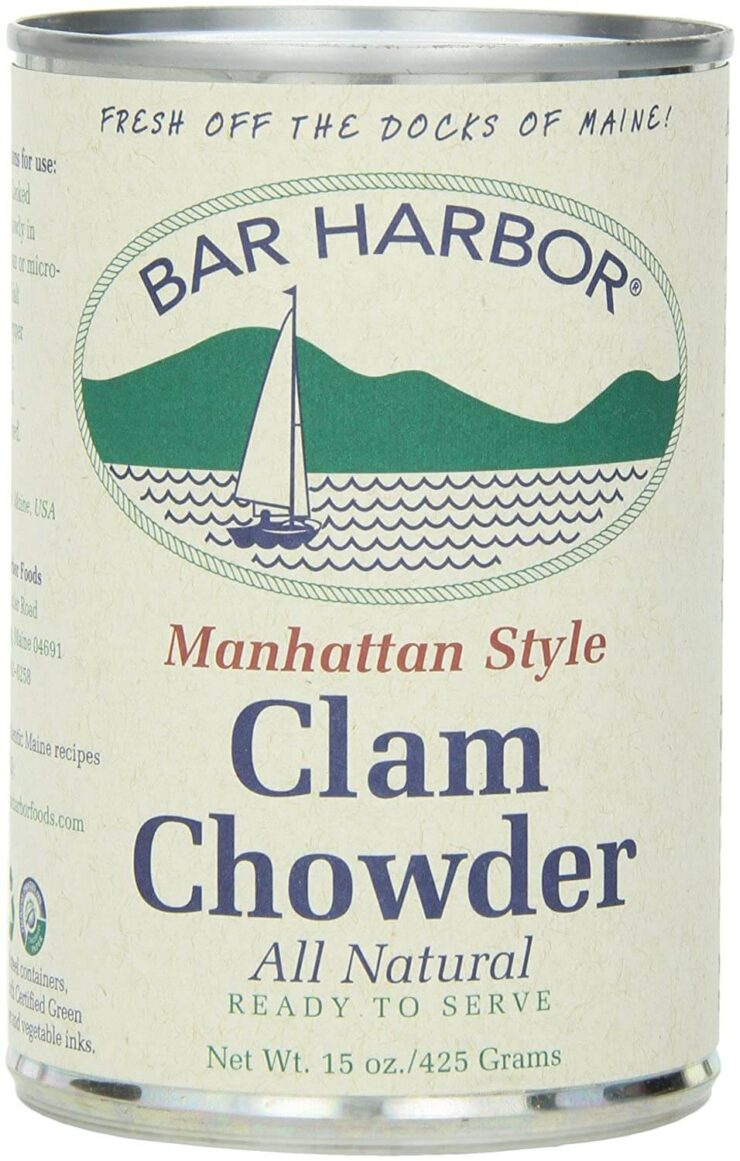
Bar Harbor Manhattan Clam Chowder.
The Bar Harbor Manhattan Clam Chowder is our best pick as it is prepared with all-natural ingredients and it is free from GMOs.
Budget Pick
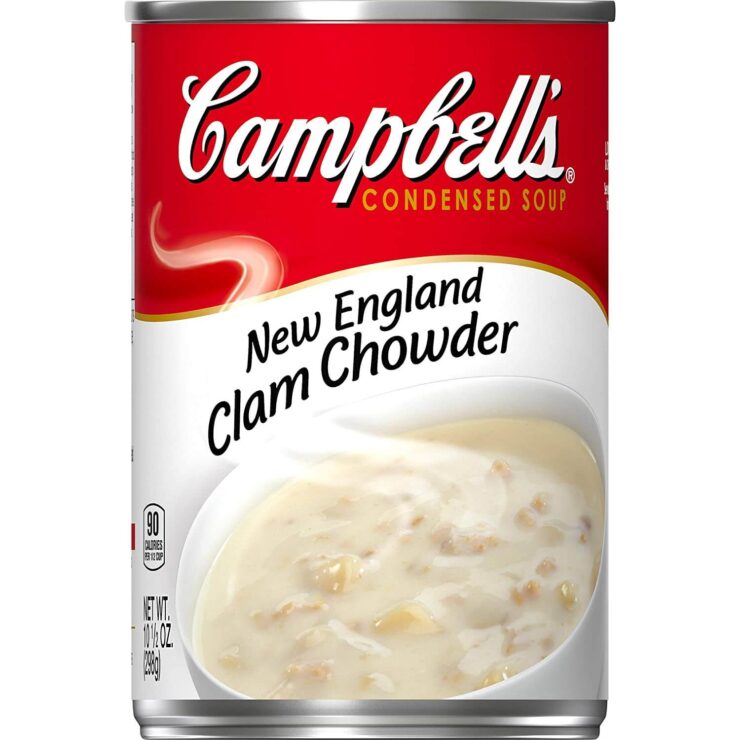
Campbell's Condensed New England Clam Chowder. For a convenient meal, at work or home, the Campbell's Condensed New England Clam Chowder is our budget pick.
Quick Comparison: Top 8 Best Canned Clam Chowders
1. Bar Harbor Manhattan Clam Chowder

Highlighted Features
The Bar Harbor Manhattan Clam Chowder is made from fresh ingredients, following a traditional Manhattan Clam Chowder recipe. The natural seasonings give it a pleasant flavor profile. However, it is not clear if the can material is BPA-free.
This product is prepared in small batches, which might have a positive impact on the quality-control. Although no ingredients containing gluten or milk are declared, this clam chowder is produced in an environment with the possible presence of milk and wheat. So it is not suitable for people with specific intolerances and allergies.
The Bar Harbor Manhattan Clam Chowder can be poured directly into a plate and consumed cold, as it is fully cooked. You can also heat the chowder in a saucepan or microwave-safe container, adding spices and herbs to taste.
Some buyers were disappointed with the number of clam pieces in the product and felt that the flavors were too neutral. On the other hand, some buyers found that this canned clam chowder gets close to a restaurant version of the dish.
2. Campbell's Condensed New England Clam Chowder

Highlighted Features
The Campbell's Condensed New England Clam Chowder has a creamy texture and it is prepared with a base of milk and potatoes, the recipe was designed to be a comfort-style food. The soup needs to be mixed with milk and heated in a saucepan or microwave, paying specific attention to the instructions on the label, as they might change with time.
The design makes it convenient for busy days, with an Easy-to-open pull tab. So you do not need to worry about having a can opener in hands. It is not a completely natural product but has no artificial flavors, which makes a considerable difference.
Some buyers complained about the number of clams and potatoes. They stated that the clam chowder had too many pieces of potato and carrot, with just a few pieces of clam. It is also important to dilute the clam chowder correctly to avoid an extra salty taste.3. Campbell's Homestyle New England Clam Chowder
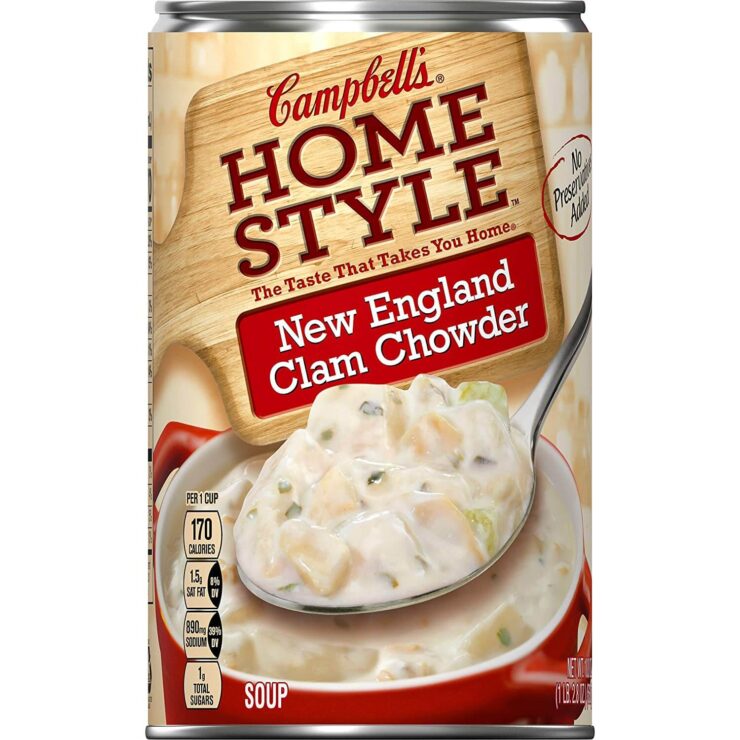
Highlighted Features
The Campbell's Homestyle New England Clam Chowder is a versatile and honest product but it is not perfect. It comes in a BPA-free can that is a positive point but contains many artificial ingredients. This clam chowder has some natural seasonings but you can still notice the artificial flavorings.
It might be a good product to have in the cupboard at home or work for when you are short of time. It is not a homemade style food as it claims to be but it is convenient. You just need a saucepan or microwave-safe container to heat it.
This product might be a good option to save money and still get a tasty dish. However, it is high in sodium. Consuming high amounts of sodium on a long term basis can present a risk to health. So you may want to choose other products if you consume canned clam chowder often.
4. Progresso Traditional, New England Clam Chowder Soup
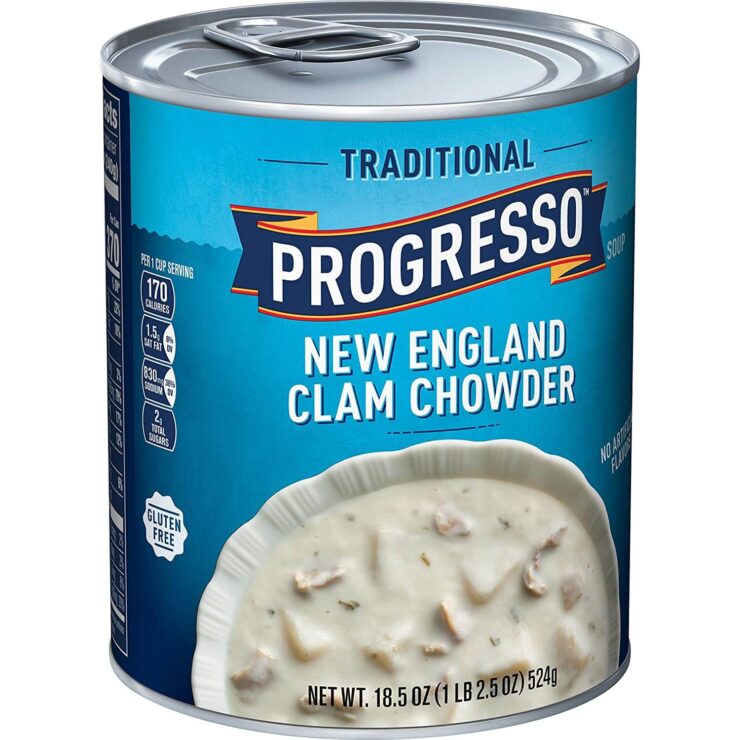
Highlighted Features
This product is manufactured following a traditional style of the recipe for New England clam chowder, so you can expect a soup made with dairy. It is gluten-free, which is positive for people allergic to this protein. However, it is good to double-check labels, as you could find more than one version of this chowder in the market.
It is a convenient product, you can heat it in a saucepan or microwave-safe container. However, you might notice the taste of this soup a little bland. Some consumers complained about a lack of spices and poor texture.
It is recommended to buy this product from a trustable seller, as some buyers had issues with damaged cans and dirty packages. So on the occasion of encountering a problem, you would be able to get an exchange or refund.5. Chincoteague Seafood New England Clam Chowder
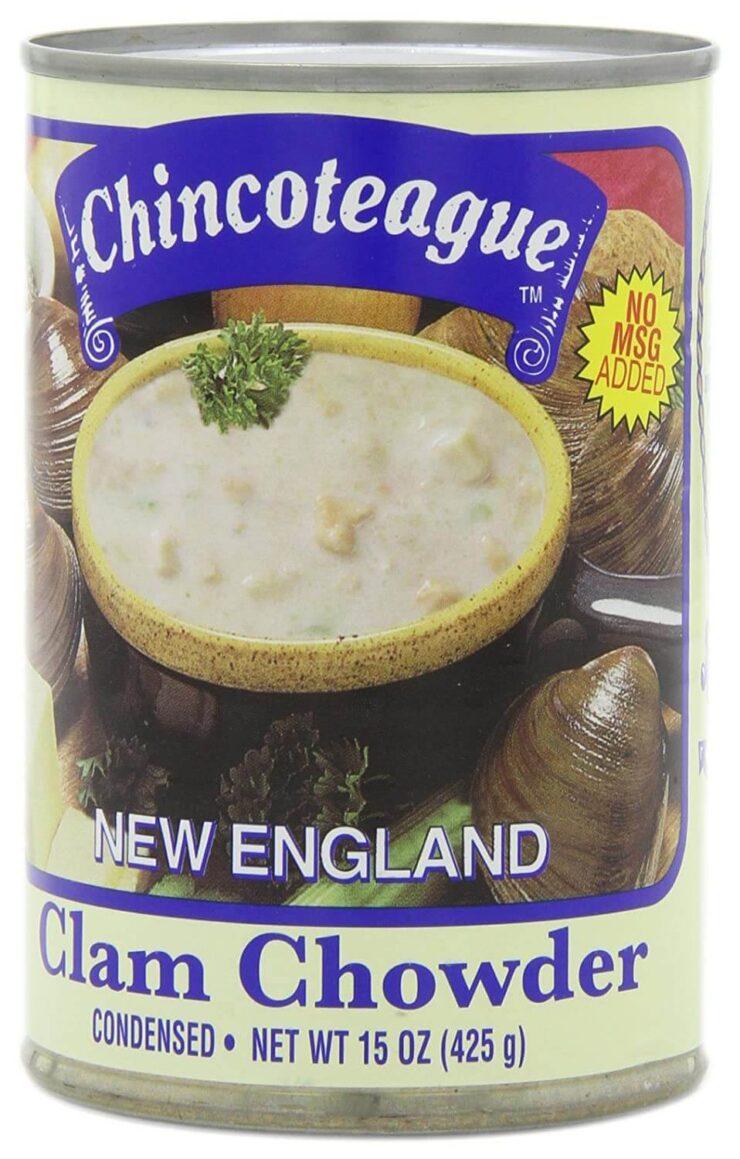
Highlighted Features
The Chincoteague Seafood New England Clam Chowder is prepared with potatoes, sea clams, clam juice, onions, and celery, among other ingredients. This chowder contains some non-natural elements, compromising the flavors.
This chowder offers more than one serving option, the first possibility is to heat it with milk. You can also choose to mix it with heavy cream to create a smoother texture. The label suggests that the amount of condensed soup should be equal to the volume of milk or cream.
The can size is about 3 ounces smaller than clam chowders from other popular brands. Also, some consumers enjoyed the texture of the soup while others considered it too thin.
6. Tony’s Clam Chowder
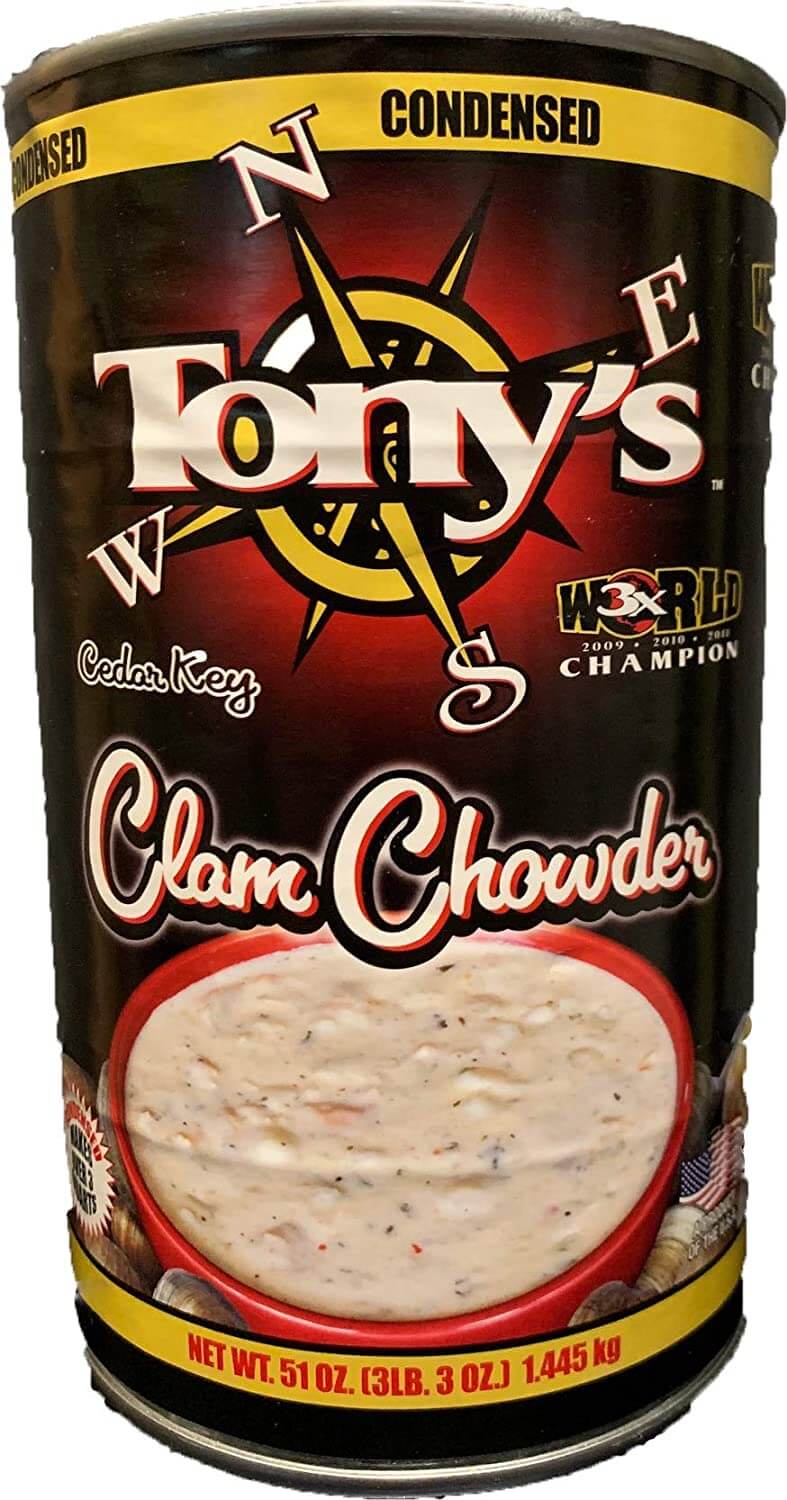
Highlighted Features
Tony’s Clam Chowder is prepared with a variety of ingredients, like clams, potatoes, garlic, onion, bell pepper, and bacon. It is not a light dish, this clam chowder is bodied and very spiced, which might create different opinions about it.
This product is manufactured in the and won some local clam chowder competitions. The can size is quite big, containing 51 ounces, which can be positive if you are cooking a large family meal. If you are looking for a time-saving meal only for one or two people, this clam chowder might not be suitable.
One of the suggested methods of preparations for this product is mixing a full can with 2 cups of heavy cream and 4 cups of half & half. Then the mixture should be heated to 180°F, stirring often. Finally, the clam chowder should cool down to 140°F before serving.
Many buyers enjoyed the spices and the flavors of this clam chowder while others mentioned that it was too much for them. So if you generally prefer more delicate foods, this product might not be suitable for you.7. San Francisco Boudin Clam Chowder Soup
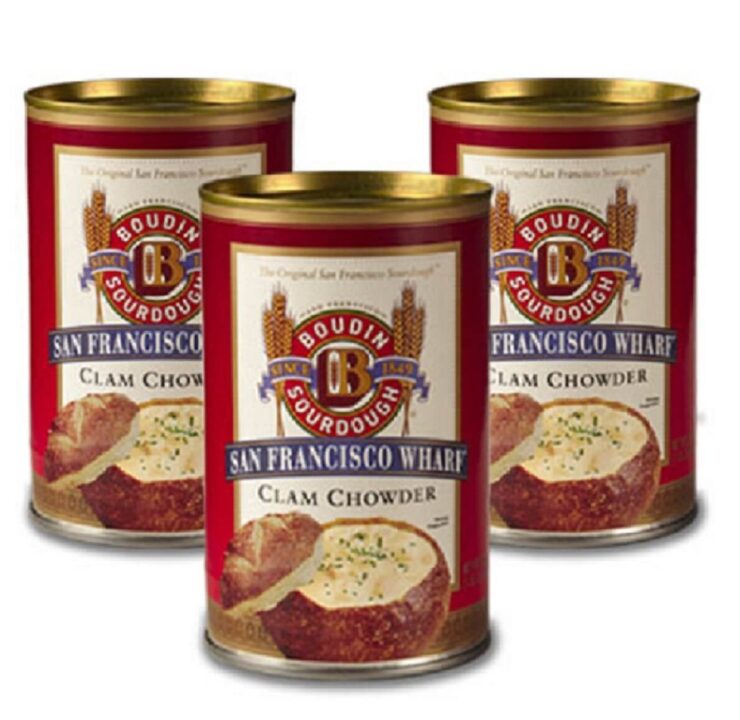
Highlighted Features
The San Francisco Boudin Clam Chowder Soup is prepared with a base of water, rehydrated potatoes, clams, soybean oil, among other ingredients. This product is manufactured under the brand of a popular bakery from San Francisco. The original dish is commonly served inside a sourdough bread instead of a bowl.
This canned clam chowder contains wheat, milk, and soy. So it can be worth taking a close look at the label if you have any allergies or intolerances.
Some buyers found that this clam chowder is tasty and gets close to the original San Francisco recipe. However, a few buyers were disappointed and said that the soup was bland and watery.8. The Black Pearl Clam Chowder

Highlighted Features
The Black Pearl Clam Chowder is prepared with a base of clams, potatoes, clam juice, and spices, among other ingredients. It is inspired by a popular recipe from Newport Rhode Island, which might create big expectations in buyers that know the original dish.
The label suggests two main methods of preparation. You can make a smooth and thick version by heating a can of soup with an equal amount of half & half. For a lighter chowder, you can replace half & half with whole milk. An interesting idea might be adding some fresh dill or other herbs to the chowder.
Some buyers were satisfied with the flavor of this clam chowder and said it is similar to the original recipe from Newport Rhode Island. The odd buyer found the soup too salty and was left disappointed with the low amount of clams.
Things to Consider Before Buying Canned Clam Chowder
Clam Chowder is a very popular dish in American cuisine. It is generally prepared with a combination of clams, tomato, milk, butter, potatoes, onions, and celery. However, there are many variations, with some of them being the Manhattan Clam Chowder and the New England Clam Chowder.
So it would be good to have in mind what kind of flavors and ingredients you are looking for. If you have any food allergies or intolerances, some canned clam chowders might not be suitable for your diet.
Milk and cream transform the clam chowder in a creamy and thick soup. A recipe with potatoes and milk would have a delicate seafood flavor, with strong dairy taste. Some canned clam chowders already include milk in the formulation, while others will ask for the consumer to add it when heating the soup. Regular fresh Milk can be a very perishable ingredient, the reason why it is used with care in canned food.
On the other hand, when Clam Chowder is prepared with a base of tomatoes, carrots, celery, and vegetables, It is not so thick. The clam chowder will have a texture similar to regular tomato soup with seafood components. So it is always good to double-check labels to make sure the clam chowder will please you.
Canned Clam Chowder is easy to transport and store, as the industrial processes make it safe for months to come. Some canned foods can maintain the nutritional value and freshness for about 2 years, depending on the fabrication method.
Canned Clam Chowder is an uncomplicated dish, you only need to open the can, transfer to a bowl or saucepan, and heat it. Adding fresh herbs right before serving is a nice idea to complement the soup. Each product will have specific instructions on how to heat the chowder effectively.
It is important to mention that the industrial processes that guarantee food safety have pros and cons. Food engineers have to add preservatives and artificial ingredients to the formulations, compromising flavor, and nutritional balance. Because of it, salt and sugar content might be higher in canned dishes.
It can be worth taking a closer look at the ingredients, taking in count additional preservatives, salt, and sugar amounts. Non-BPA-lined cans are also an advantage. Sometimes the labels will try to hide important details, like hydrogenated fat, GMOs, and odd chemicals.
The History of Canned Clam Chowder
The first Clam Chowder recipe was prepared with milk and potatoes. The exact origin is a mystery but it was probably introduced by British, Nova Scotian, or French settlers in the US. It became a common dish in the Eastern United States around the 18th century.
The first recipe of Clam Chowder with tomato was created in the 20th century, registers suggest it occurred around 1919. There was a legal episode involving this dish, in 1939, when the state of Maine proposed to declare illegal the use of tomatoes in traditional Clam Chowder.
The dish became so popular around the United States that many varieties started to appear. As recipes are not immutable, people started to make adaptations, excluding and inserting different ingredients, like pork, green onions, and peppers. Then clam chowder became a historic patrimony and loved dish.
It is not clear when the first canned clam chowder appeared. With canned food popularity increasing in Europe during the wartime, can production methods arrived in the United States. With clam chowder being a common dish, companies started to look at it as a business opportunity.
In the 19th century, food manufacturers highly increased the capability of canned food production. There was a competitive market where brands aimed to offer the best variety and quality. So many canned clam chowder varieties appeared in the market, making it harder for consumers to decide which one to buy.
One of the pioneers in the United States was Snow’s Clam Chowder, first manufactured in 1920. The visual style of labels and recipes changed a lot since then.
Across history, canned foods played a very important role to guarantee safe and convenient food options. Nowadays canned foods are much safer and trustable than they used to be, and canned clam chowder is not an exception.
How Canned Clam Chowder is made
Canned Clam Chowder is made from fresh, processed, and sometimes artificial ingredients too. They are combined according to a specific standard recipe. Each manufacturer will have a different proportion and variety of components.
Clam Chowder made in a restaurant or at home generally will not have a strict recipe. Mostly because you will eat them right away, so they do not need to have a long shelf life. Industrial processes require a higher level of accuracy to guarantee that the final product will be safe, tasty and resist long time storage.
Common natural ingredients in canned clam chowder include:
Clam stock, potatoes, water, clams, tomato puree, celery, carrots, milk, vegetable oil, onion, butter, bell peppers, and spices
After the clam chowder is cooked, the canning takes place. This method preserves food from spoilage, as cans are hermetically sealed and sterilized in high temperatures. It kills microorganisms that could potentially grow and cause harm to consumers.
The sterilization guarantees that the clam chowder will be ready to eat straight from the can. So it will not cause you any harm or food poisoning if you do not cook it. However, canned clam chowder generally needs to be heated and sometimes dissolved to be at its best.
Canning is a safe process that preserves the majority of nutrients in food. Carbohydrates, proteins, fats, and some vitamins are conserved. So the canned clam chowder still keeps most of the nutrients you would find in a homemade or restaurant version. Unfortunately, some vitamins and a few nutrients do not resist the high temperatures.
The canning needs to be done with precision, as the improper techniques can drive to Botulism Bacteria to Grow. This microorganism thrives in oxygen-free environments, the reason why cans are at risk.
It is a good practice to always inspect cans before consuming the clam chowder. If the container looks damaged, abnormal, or cracked, it might be better not to consume. These cases are rare but might happen.
How to Store Canned Clam Chowder
Canned Clam Chowder, like most canned foods, should be stored in a dry cool place, except when the label explicitly mentions something different. Exposing the can to high temperatures or excessive light could make bacteria grow inside the can. Freezing temperatures are not recommended, as they affect the food inside and the metals in the can.
Canned clam chowder should not be consumed after the expiration date. This date represents the end of the shelf life of the product, it is a safety measure. So consuming canned clam chowder out of date could result in a serious health risk.
After you open the can, it might be possible to store leftovers in the fridge. The best guidance is to read the manufacturer's instructions, they will tell you for how many days you could keep it refrigerated. Once opened, the chowder gets in touch with microorganisms and would last for just a few days.
Some brands might recommend consuming the product all at once, with leftovers being disposed of. It is recommended to follow the label’s instructions, as the durability of the product is generally tested.
How to Thicken Canned Clam Chowder
So you have followed all the instructions in the label but you still feel that the chowder is not thick enough. One solution is to add corn starch. For one can of chowder, one teaspoon of cornstarch would work well.
You would need to dissolve the cornstarch in the same amount of cold water before adding it to the chowder. Corn starch needs heat to act, so as soon as it reaches the right the temperature, the chowder will get thicker.
More or less corn starch might be required according to the volume of chowder that you are heating. Using too much cornstarch could result in bad flavors and gelatin texture.
Another alternative is to add mashed potatoes to it. It is not a time-saving option but results in a much richer texture with better taste. Wheat flour is not recommended for this purpose.
Comparing Ingredients in Canned Clam Chowder
Canned clam chowder can come in a variety of formulations. Some are almost 100% made from natural ingredients while others have more artificial elements. How to know what is the best canned clam chowder?
Many brands will highlight that they did not use artificial preservatives or artificial flavors. They know that consumers tend to choose more natural canned foods, so they might want to hide some compromising details too. Generally, the small letters will tell you the truth.
How do you know what you should be looking at?
Sometimes, the package will declare that no artificial flavorings were used but the manufacturer added many artificial preservatives. Preservatives increase the durability of the food while flavorings are related to taste. So if the label does not highlight a phrase like ‘made from natural ingredients’, there is probably something hidden.
Common artificial ingredients include nitrites, Butylated Hydroxyanisole, sulfites, Sodium Benzoate, Potassium Benzoate, Benzene, Monosodium Glutamate, and Sulfur Dioxide. Some of them are more inoffensive than others, as they need to be consumed in large doses and for a long time to cause harm. Food poisoning poses a higher risk than artificial preservatives.
So we are not saying that artificial ingredients are villains. They guarantee food safety and protect you from bacteria and microorganisms. However, if there is an option to consume safe canned food with only natural ingredients, that would taste better, and be better for your health in a long term perspective.
How are ingredients organized in food labels?
You can judge a can by its label. The first element in the list will be the most used ingredient, followed by the other compounds, in a decrescent order. This information helps you to decide, as you can know exactly what is inside.
Canned clam chowders with all Non-GMO ingredients are more attractive too. With the development of new agricultural techniques, GMO foods are becoming more present in food labels.
Genetically modified organisms or GMOs are organisms that had their genetic materials altered in a lab. Their DNA is transformed to increase resistance to plagues, substances, or to add a new characteristic. Evidence about their safety is still unclear, with contradictory research results.
How to make Canned Clam Chowder Taste Better
It is true that most canned foods come ready to eat and are tasty without any additions. However, some tips can help to improve the taste of canned clam chowder.
Always reads the instructions in the can. The manufacturer is commonly the best authority to provide you with advice about the durability and use of a product.
You might find it useful to add fresh herbs and spices if you have them in hand. It is good to taste the clam chowder after heated and feel if it needs more salt, pepper, or spices. Canned Clam Chowder is generally developed to please a large number of consumers but not everyone. So if you feel that something is missing, do not be afraid to add a personal touch.
A common complaint from buyers is that canned clam chowder does not have enough clam pieces. Many brands present this issue, this might be related to cost.
Because of it, some people like to heat the canned clam chowder in a large saucepan and then add in more clams. It might seem strange but it is a good option when you wish to save cooking time and make the clam taste stronger in the soup.
Some spices and dried herbs you might want to add:
- Garlic powder
- Dried Parsley
- White pepper
- Dried Basil
- Cayenne pepper
- Chili Powder
- Dried Tarragon
- Dried bay leaves
Fresh herbs that can be added:
- Parsley
- Basil
- Thyme
- Oregano
- Basil
Extra ingredients to consider:
- Olive oil
- Extra clams
- Minced garlic
- Extra butter
Concerns Around BPA in Canned Clam Chowder
Bisphenol A (BPA) is a chemical compound generally found in aluminum and tin cans. Studies have shown that BPA is linked to many health problems, including obesity, diabetes, and cancer. Studies suggest that small doses of it are enough to cause toxicity.
BPA was first used in plastic bottles and food containers. It is still used in can manufacturing, representing a possible risk to consumers. FDA has banned the use of BPA in baby products in the USA but some canned foods still contain it.
Data showed that in 2019, 90% of cans produced in the USA were BPA free. With recent studies showing the toxic potentiality of this compound, the food industry is reacting, investing in cans that are safer and do not represent health risks.
With BPA still being allowed by law in many countries, it might be worth to keep an eye at labels. Many manufacturers highlight in the description when a product is BPA free. Consumers generally tend to feel safer if this information is there.
Conclusion
Canned clam chowder is a handy meal option to have at work or home. Some cans come with an Easy-to-open pull tab, which makes them even more convenient. If you would like to get the best out of the product, our suggestion is to heat the chowder and add some spices to boost the flavors.
Choosing the best canned clam chowder may not be an exact science but knowing how to read labels makes a big difference. If you spot ingredients with long or odd names, they are probably artificial additives. All-natural products like the Bar Harbor Manhattan Clam Chowder often taste better but come at higher prices, so you might want to consider artificial ingredients to get a good value for money.
